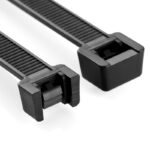Do Police Use Zip Ties?
Yes, police officers frequently use zip ties as an alternative to traditional metal handcuffs, especially in situations requiring mass detainment or temporary restraints. These specialized zip ties, also known as flex cuffs or cable ties as handcuffs, are commonly used in riot control, large public gatherings, and high-risk operations due to their ease of use and cost-effectiveness.
What Is The Police Zip Tie?
Police zip ties, also called handcuff zip ties or zip tie cuffs, are heavy-duty, disposable restraints designed to secure a suspect’s wrists or ankles. Unlike standard cable ties, these restraints are made of reinforced nylon with high tensile strength to prevent breakage and ensure detainees remain securely restrained until proper processing.
When Did Police Start Using Zip Ties?
Police forces began using zip tie handcuffs in the late 20th century as an efficient alternative to metal handcuffs. Initially developed for military applications, zip tie cuffs gained popularity among law enforcement agencies due to their lightweight, low-cost nature, and ease of transport. Over time, they have become a standard tool in riot control and tactical police operations.
What Size Zip Ties Do Police Use?
The size of police zip ties varies depending on the manufacturer, but most law enforcement zip tie handcuffs measure between 0.25 to 0.5 inches wide and 10 to 20 inches long. These dimensions allow for secure restraint while accommodating different wrist sizes. The tensile strength of police zip ties is typically around 250-400 pounds, ensuring that they cannot be easily broken.
Why Do Police Use Zip Ties Instead of Handcuffs?
| Feature | Description |
| Robustness | High-tensile strength materials prevent breakage, ensuring security in high-pressure situations. |
| Lightness | Lightweight design allows officers to carry multiple restraints without added weight. |
| Low Cost | More affordable than metal handcuffs, making them cost-effective for law enforcement agencies. |
| More Humane Detention | Reduces strain on wrists and shoulders, minimizing the risk of abrasions or skin damage. |
| Maintain Optimal Hygiene | Disposable design eliminates cross-contamination risk, reducing the spread of diseases. |
| Excellent Durability | Resistant to heat, cold, and moisture, ensuring long-lasting use in various environments. |
| Flexibility | Adjustable to accommodate different wrist and ankle sizes, making them versatile. |
| Ease of Use & Quick Response | Allows officers to quickly secure suspects with minimal effort, ideal for high-risk situations. |
Robustness
Police zip ties are designed with high-tensile strength materials, ensuring that suspects cannot break free without specialized cutting tools. Their reinforced nylon construction provides durability and reliability in high-pressure situations.
Lightness
Unlike traditional handcuffs, which are made of metal and can be cumbersome, police zip ties are lightweight, allowing officers to carry multiple restraints without adding unnecessary weight to their gear.
Low Cost
Metal handcuffs can be expensive, costing between $18 and $150 per pair. In contrast, zip tie cuffs are far more affordable, making them a cost-effective option for law enforcement agencies operating on tight budgets.
More Humane Detention
Zip ties offer a more comfortable restraint option by reducing strain on the suspect’s wrists and shoulders. The smooth surface and rounded edges minimize the risk of abrasions or skin damage compared to traditional metal cuffs.
Maintain Optimal Hygiene
Unlike reusable metal handcuffs, zip ties are disposable, eliminating the risk of cross-contamination from bodily fluids. This helps prevent the spread of diseases such as HIV and hepatitis, making them a safer option for both officers and detainees.
Excellent Durability
Zip ties are resistant to environmental conditions, including heat, cold, and moisture. Unlike metal handcuffs, they do not rust or degrade, making them suitable for use in various climates and operational conditions.
Flexibility
Police zip ties are adjustable and can accommodate different wrist and ankle sizes. Their flexibility makes them an ideal option for securing individuals of varying body types without the need for multiple restraint sizes.
Ease of Use and Quick Response
One of the biggest advantages of zip tie cuffs is their ease of use. Officers can quickly secure a suspect’s wrists with minimal effort, reducing the risk of escape. This is particularly useful in high-risk situations where speed and efficiency are critical.
Find The Best Police Zip Ties At Niuli
Niuli Electric‘s police cable tie is designed for secure and versatile binding, offering a reliable solution for both industrial applications and law enforcement use.
6 Features of Niuli Police Zip Ties
| Feature | Description |
| Dual-Binding Design | Functions like two connected cable ties, allowing for the simultaneous fixation of two pipes or cables, and suitable for police, SWAT teams, and security personnel. |
| High-Quality Material | Made from UL Approved Nylon 66, ensuring durability and strength. |
| Flammability Rating | Certified to UL 94V-2 for fire safety compliance. |
| Temperature Resistance | Supports an installation temperature of -10℃ to 85℃ and a working temperature range of -40℃ to 85℃ for reliable performance in various environments. |
| Color Options | Available in Natural (White) and Black, with custom colors available upon request. |
| Industry Certifications | Compliant with UL, CE, RoHS, REACH, and SGS standards for safety and quality assurance. |
Conclusion
Police zip ties provide a reliable, cost-effective, and efficient alternative to traditional handcuffs. Their robustness, lightweight nature, affordability, and hygiene benefits make them a valuable tool for law enforcement agencies. By incorporating zip tie handcuffs into their operations, police forces can ensure quick and secure detainment, enhancing overall safety and effectiveness.






